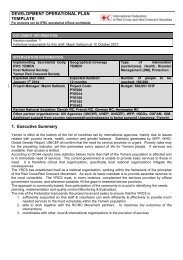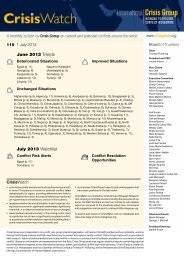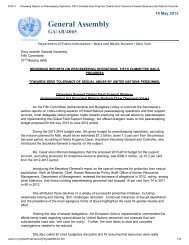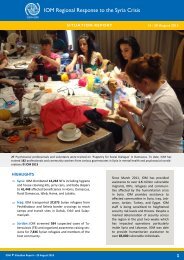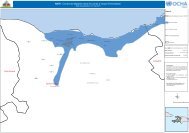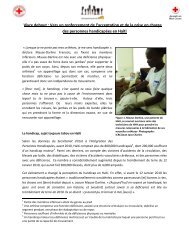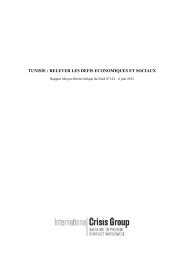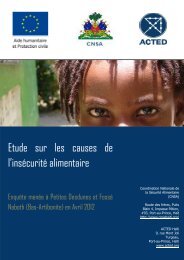SOMALI NUTRITION STRATEGY 2011 – 2013 - ReliefWeb
SOMALI NUTRITION STRATEGY 2011 – 2013 - ReliefWeb
SOMALI NUTRITION STRATEGY 2011 – 2013 - ReliefWeb
You also want an ePaper? Increase the reach of your titles
YUMPU automatically turns print PDFs into web optimized ePapers that Google loves.
60<br />
In this section, internationally recognised, proven effective interventions are linked with the<br />
ANNEX<br />
3<br />
JUSTIFICATION OF OUTCOMES AND KEY<br />
APPROACHES ADOPTED IN THIS <strong>STRATEGY</strong><br />
priorities identified for Somalia and what is feasible in the context.<br />
Outcome 1 Improved access to and utilisation of quality services for the management<br />
of malnutrition in women and children<br />
The Lancet series on Maternal and<br />
Child undernutrition (2008) highlights<br />
that recent studies demonstrate new<br />
commodities such as ready to use<br />
therapeutic food (RUTF) can be used<br />
effectively to manage severe acute<br />
malnutrition in community settings. The<br />
Community based management of acute<br />
malnutrition (CMAM) approach increases<br />
the number of children who can be<br />
treated, reduces exposure to disease<br />
and reduces drop-out rates compared<br />
to standard management of acute<br />
malnutrition approach using therapeutic<br />
milks in a centre based setting (Collins et<br />
al 2006).<br />
Child eating Plumpynut Save the Children, Somaliland<br />
The development of RUTF and the CMAM approach has opened the door to significant expansion<br />
of services for the management of severe acute malnutrition in Somalia where the weak health<br />
infrastructure and high insecurity have been major challenges to centre based management. Since<br />
2006, 250 OTPs supported by UNICEF have opened. Some coverage gaps remain particularly<br />
with respect to access to stabilisation centres or adequate facilities for referral of complicated<br />
cases. This is especially so in South Central Somalia where the majority of SAM cases live but<br />
humanitarian space is most limited. Quality of services is also an issue. Thus, the enhancement<br />
and expansion of quality interventions for the management of acute malnutrition in accordance<br />
with newly developed guidelines remains a priority. Whilst poor coverage of referral centres<br />
continues to be a major constraint to providing quality services, the promotion of community<br />
mobilisation as a key activity of all OTPs is an important approach to improving coverage and<br />
early diagnosis to reduce the presentation of complicated cases in need of referral. As it is such a<br />
key activity in this context, community mobilisation requires dedicated staff and resources.<br />
The results of the micronutrient and anthropometric survey 2009 underscore the importance<br />
of scaling up services for the treatment of micronutrient deficiencies. Treatment services are<br />
currently limited by weakness in the health system and by poor access to and utilisation of health<br />
facilities. However, while not a remit of this strategy, health system strengthening is an overarching<br />
goal. The development of simple Somali specific standardised protocols in conjunction with preservice<br />
and in service training modules on diagnosis and treatment of MND for all health staff,<br />
and commitment to timely provision of supplies, will contribute to improving treatment services.




